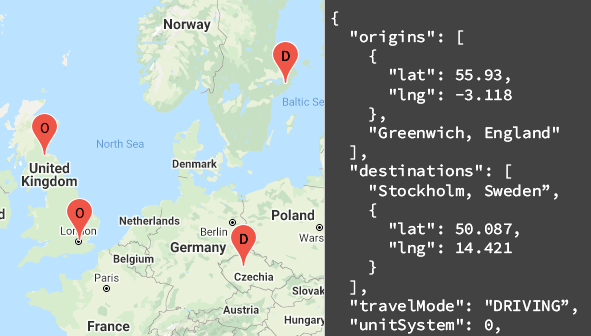簡介
Distance Matrix API (舊版) 是一項服務,可接受含有起點和目的地的 HTTPS 要求,並提供指定交通方式的距離和時間。針對每個起點和目的地的組合,傳回移動距離和時間。
使用 Distance Matrix API 的好處
您可以運用 Distance Matrix API,判斷多個可能起點和目的地之間最有效率的路線。例如要派哪些工作人員前往工作地點,或是要從哪個倉庫寄送包裹。
Distance Matrix API 的用途
透過 Distance Matrix API,您可以提供出發地和目的地矩陣的移動距離和所需時間。你可以指定多個選項,包括交通方式 (例如開車、騎單車、大眾運輸或步行),以及大眾運輸方式 (例如公車、地鐵、火車、電車或鐵路)。
Distance Matrix API 會根據起點和終點間的建議路線提供資訊。你可以要求下列類型的距離資料:
- 所選交通模式的距離
- 距離 (公里或英里)
- 預估交通時間

Distance Matrix API 的運作方式
距離矩陣 API 會使用任意數量的起點和目的地,並傳回每個起點與所有要求目的地之間的距離和行程時間,從要求中的第一個起點開始,逐步前往下一個起點。
例如,如果您的請求指定 A 和 B 為起點,C 和 D 為終點,則它將按以下順序返回距離和旅行時間:
- A 到 C
- A 到 D
- B to C
- B 到 D
以下範例顯示了來自兩個來源位址(華盛頓特區和波士頓)且目的地為紐約市(紐約州)的請求,格式為 JSON:
https://maps.googleapis.com/maps/api/distancematrix/json ?destinations=New%20York%20City%2C%20NY &origins=Washington%2C%20DC%7CBoston &units=imperial &key=YOUR_API_KEY
資源
下表列出 Distance Matrix API 提供的資源,以及傳回的資料。
| 資料資源 | 傳回的資料 | 傳回格式 |
|---|---|---|
| 距離矩陣
以地點 ID、地址或經緯度座標的形式提供出發地和目的地資訊。 |
|
|
如何使用 Distance Matrix API
| 1 | 做好準備 | 請先按照「設定 Google Cloud 專案」一文中的操作說明完成設定, |
| 2 | 試試距離矩陣要求 | 取得 API 金鑰後,您就可以直接在瀏覽器中開始測試 Distance Matrix API。如需範例,請參閱入門指南中的「要求範例」。 |
| 3 | 撰寫更複雜的要求 | 請嘗試提供多個起點和目的地的要求。瞭解可限制計算的可選參數,例如指定出發時間或路線限制。請參閱距離矩陣要求和回應指南中的「選用參數」。 |
| 4 | 瞭解回覆的基本概念 | 請探索資料回應,準備在應用程式中使用距離矩陣資料。詳情請參閱「距離矩陣回應」。 |
| 5 | 將距離矩陣資料整合到自己的應用程式! | 您可以使用這項資料計算旅行距離和時間。 |
可用的用戶端程式庫
透過下列任一用戶端程式庫,以您選擇的語言呼叫這項 API:
Google 地圖服務適用的 Java、Python、Go 和 Node.js 用戶端都是社群支援的用戶端程式庫,並依據阿帕契 2.0 授權的條款提供開放原始碼。您可以從 GitHub 下載這些用戶端,並查看安裝操作說明和程式碼範例。

